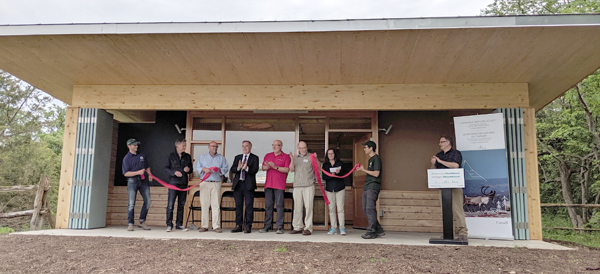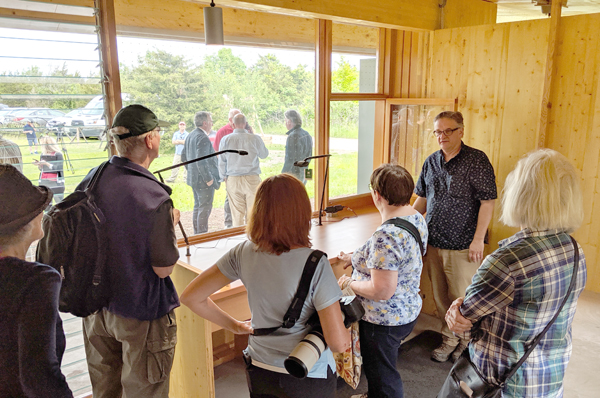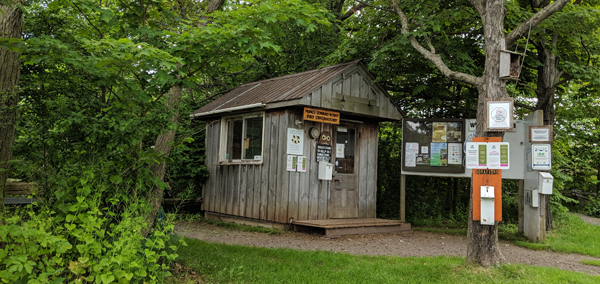Federal funding for the birds in Prince Edward County
Administrator | Jun 24, 2019 | Comments 0
 Birds migrating through the Prince Edward Point National Wildlife area will have luxury, state-of-the-art accommodations while being monitored and banded.
Birds migrating through the Prince Edward Point National Wildlife area will have luxury, state-of-the-art accommodations while being monitored and banded.
A new migration monitoring station, leased to the Prince Edward Point Bird Observatory (PEPtBO) by the federal government, was unveiled Monday.

Lesley Dunn, Regional Director with Canadian Wildlife Services Ontario
“It’s beautiful, and very functional too,” said Lesley Dunn, Regional Director with Canadian Wildlife Service Ontario. “It’s solar-powered and off the grid, sheathed in Ontario White Cedar, with a picture window that serves as a portal for us to see bird banding in action, and with a front ‘porch’ that can be closed to shelter school groups when storms come off the lake, and opened as a stage for public presentations.”
It also features a UV lighting system.
“For those who don’t know, it is possible to determine the age of some birds, such as saw-whet owls, by how much UV light their feathers reflect,” said Dunn, inviting the gathered crowd to come out to the Observatory in the fall to see the wonder of black light owls.
The station was officially opened Monday afternoon by Bay of Quinte MP Neil Ellis, with Dunn, Graham Bryan, Manager with Protected Areas (Ontario), Peter Fuller, president PEPtBO, PEC Mayor Steve Ferguson and councillors John Hirsch and Mike Harper.

Graham Bryan, Manager, Protected Areas (Ontario) gave a tour inside the new building showing its features for the bird bander and volunteers.
“This is likely the only time when hearing that a government’s funding is ‘going to the birds’ is a good thing,” said Ellis. “Environment and Climate Change Canada’s provisions will help the Prince Edward Point Bird Observatory to become an important site for increasing our community’s awareness of the bird migrations occurring all around us each year.”
Dunn noted Prince Edward Point was selected as one of 10 National Wildlife Areas across the country for investment to improve the visitor experience and better connect Canadians to nature. There are 55 NWAs across Canada.
“The migration monitoring station was a key part of that investment, along with an improved Point Traverse trail, and interpretive signage to offer more ways to connect with our shared natural heritage and to bear witness to one of North America’s great migrations.”
One of the goals of the Connecting Canadians to Nature initiative is to increase public access to the selected NWAs while managing their visitation so that activities do not interfere with the conservation of wildlife.

Peter Fuller, PEPtBO president
Peter Fuller, PEPtBO president, said the observatory has been partnering with Canadian Wildlife Service form more than 20 years to monitor migrations.
“Thanks to CWS’s generous support, this volunteer-run research station is contributing to the knowledge and conservation of bird populations.”
Large numbers of Northern Saw-whet Owls move through the area in the fall resulting in some 1,500 banded in one season at PEPtBO, the largest movement of these owls recorded anywhere in the world.
The ECCC has also supported Nature Canada’s NatureHood program, which has helped PEPtBO share banding and migration education with thousands of students from local schools.
Originally slated to become a resort and marina, the land at Prince Edward Point became a National Wildlife Area in 1978 to recognize and protect the important stopover habitat for migratory birds. It is also home to a number of species-at-risk and designated as one of Canada’s Monarch Butterfly Reserves as part of an International Network.
The Kingston Field Naturalists started to formally recognize its importance in the mid-1960s and in 1975 began banding birds in the nearby lighthouse through the 80s. The volunteer-run Prince Edward Point Bird Observatory was formed in 1995 to resume monitoring, reporting and promotion of the analysis of bird migration for the south shore.

The cramped-quarters station used most recently for bird banding.
Today, the point is the winter home to upward of 200,000 Long-tailed ducks, among others, and in the spring and fall, more than 300 species are recorded. Up to 2,000 hawks a day are regularly observed.
“These lands and this special place will remain protected in perpetuity,” said Dunn. “Allowing for your children and your children’s children to enjoy the biodiversity that Prince Edward Point has to offer.”
Filed Under: Arts & Culture • Featured Articles
About the Author:
































